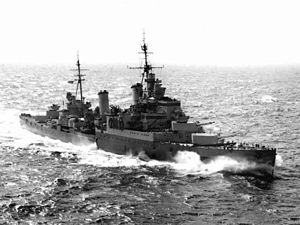Our website is made possible by displaying online advertisements to our visitors.
Please consider supporting us by disabling your ad blocker.
HMS Sheffield (C24)
 Sheffield underway in 1944
| |
| History | |
|---|---|
| Name | Sheffield |
| Namesake | Sheffield |
| Builder | Vickers-Armstrongs, High Walker |
| Yard number | 5[1] |
| Laid down | 31 January 1935 |
| Launched | 23 July 1936 |
| Commissioned | 25 August 1937 |
| Identification | Pennant number: 24, from 1948: C24[1] |
| Motto | |
| Nickname(s) | Shiny Sheff |
| Honours and awards |
|
| Fate | Scrapped at Faslane, 1967 |
| Badge |  |
| General characteristics | |
| Class and type | Town-class light cruiser |
| Displacement | |
| Length | 591 ft (180.1 m) (overall) |
| Beam | 62 ft 3 in (19 m) |
| Draught | 17 ft (5.2 m) |
| Installed power |
|
| Propulsion | 4 screws; 4 geared steam turbines |
| Speed | 32 knots (59 km/h; 37 mph) |
| Range | 7,000 nmi (13,000 km; 8,100 mi) at 16 knots (30 km/h; 18 mph) |
| Complement | 748 |
| Sensors and processing systems |
|
| Armament |
|
| Armour | |
| Aircraft carried | 3 |
| Aviation facilities | 1 fixed catapult |
HMS Sheffield was the third of ten Town-class light cruisers of the Royal Navy. The ship was laid down in January 1936, launched in July 1936, and commissioned in August 1937. She was active in all major naval European theatres of the Second World War, in the Atlantic Ocean, the Mediterranean Sea and the Arctic Ocean.
Her career started with service in the Home Fleet, which took her on patrols against German blockade runners and on actions during the Norwegian Campaign. In August 1940 Sheffield was transferred to Force H stationed in Gibraltar. During her service with Force H, most of the operations involved either ferrying aircraft or escorting convoys to Malta. Sheffield also operated against German surface raiders in the Atlantic, taking part in the chase for the German battleship Bismarck. On 26 May 1941, she directed torpedo bombers from the aircraft carrier Ark Royal to Bismarck, but took no part in the actual sinking of Bismarck one day later.
In January 1942, Sheffield was assigned to the escort of Arctic convoys to Northern Russia. But in March she was damaged by a mine and needed four months repair. In September Sheffield went back to the Arctic, but in October Arctic convoys were suspended in preparation for Operation Torch. Sheffield participated in Operation Torch as part of the Eastern Task Force, which covered the landings at Algiers. Arctic convoys resumed in December 1942 and Sheffield went back to the Arctic. In that same month, she was part of a cruiser force that repelled a German attack on Convoy JW 51B in the Battle of the Barents Sea. During the battle, Sheffield damaged the German heavy cruiser Admiral Hipper and sank the destroyer Friedrich Eckoldt. In March 1943 Arctic convoys were suspended once more, this time because of the threat of the German surface fleet stationed in Norway. Sheffield moved again to the Mediterranean and took part in Operation Avalanche. When the threat of the German surface fleet was much reduced by the disabling of the German battleship Tirpitz in September, Arctic convoys were resumed in November. In December 1943 during the Battle of the North Cape, Sheffield assisted in the sinking of the German battleship Scharnhorst whilst escorting convoy Convoy JW 55B.
Sheffield went in for an extended refit in 1944 and saw no more service during the war. She was placed in reserve for a first time in 1959, and after a short reactivation Sheffield was decommissioned in 1964 and finally scrapped in 1967.
Previous Page Next Page


